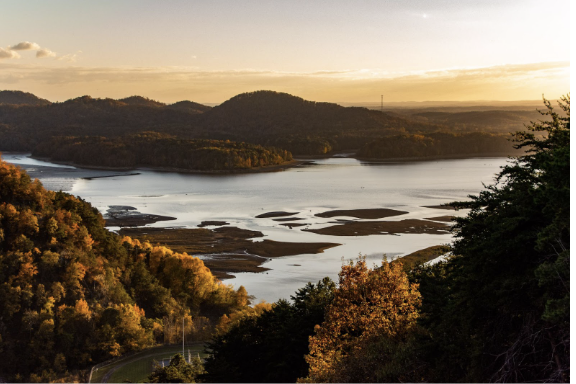Travelers arriving within the Appalachia region are greeted by whispers from the townsfolk. Screams from the local politicians, begging people to stay inside at night. One adventurous traveler takes a risk and enters the woods at night, watched by eyes and guided by voices in the woods. The traveler runs out of the woods, and all the tourists leave. The townsfolk revered in joy after making another traveler leave. Most Americans have heard of their infamous creatures residing within the deciduous forests deep within the Appalachian region. However, the locals remain within Appalachia, generation after generation. Foreigners in the area refuse to travel in case of a run-in with a Wendigo or Skinwalker. Many outsiders wonder if these creatures and rules are real or a hoax that keeps tourists away. Yet, through extensive research and resounding numbers of people still residing within the region. Through centuries of storytelling and the modernization of these creatures, Appalachian folktales are a perfect example of how to market something that results in people scrambling away in fear.
The mysterious Appalachian region, filled with Fauna and Flora. Spread across 13 states, spanning 206,000 square miles, according to the Appalachian Regional commission. This large region of trails and mountain ranges, filled with small towns and unexplainable occurrences. Since early Indigenous people, there have always been claims of a variety of dangerous creatures, hunting for their next meal. One of the earliest accounts of a Appalachian beast is the Wendigo. According to an excerpt published by Britanic in 2023, the Wendigo is a 15 foot tall creature with glowing yellow eyes razor-sharp fangs and claws. The Wendigo would be formed by possessing a human, typically a human who had a greedy or gluttonous lifestyle. This would enact the catalyst to become a cannibalistic beast. There has been one reported case where the Wendigo was blamed for a cannibalistic crime and used as evidence within a federal court. In 1879, Alberta, Canada, a person named Swift Runner claimed a Wendigo told him to eat his family. He was found guilty for murder and faced the death penalty, according to a 2023 Britanica excerpt. Another aged folktale that still lingers in Appalachia today is Moth-Man. Moth-Man, a creature with origin from Point Pleasant, West Virginia, according to an article released in 2021 from the Smithsonian center for Folklife and Cultural Magazine. Moth-Man is a creature of the night, first claimed to be spotted on route 62, November 15th, 1966. Moth-Man was described as a rising helicopter, soaring around 100 miles per hour. Moth-man has never been given an official description as many accounts vary on details, but it is believed to be just an oversized moth with red eyes. Moth-Man is reported to be rather deadly, and on the hunt for blood. All accounts of experiencing Moth-Man are due to the territorial nature of the creature. Most reports occurred on main highways within West Virginia where Moth-Man would reside in the trees. However, infamous reports of a gigantic flying insect have died out.
Latterly, reports of a farm animal named Skinwalkers have been making headlines. Skinwalkers were originally a story created by the Navajo tribe that they are shape-shifters that only had intentions of pure evil, cited from Denver Public Library in a 2013 article. All three folktales are some of the most famous and oldest folktales from the Appalachian region. Over the past couple decades, their prominence within media began to fade after skeptic tourists tried to prove these mythical theories false. Especially tourists who would disrespect the area, grasping for any form of evidence that could discredit all the infamous tales. Although, social media began to have a field day with these stories. With new outlets of expression, such as Instagram or Tiktok. Content creators located within the region began to use their knowledge of native folktales to scare off tourists from disrupting their hometowns.
One of the most notable content creators who uses their excellent storytelling skills and expansive knowledge of Appalachian folklore is The Appalachian Storyteller. This content creator releases stories throughout all media platforms, most notably Youtube. All of these stories seemed a tad bit dramatic, but their viewers believed every second of it. Many commenters claimed that they would never go to an Appalachian town, knowing that a Wendigo could stalk them in the dead of night ora cannibalistic gnome comes sulking at their door.
Inside Virginia’s vibrant wooded areas, there are many sayings about how to survive when encountering a bear. In the interior of Appalachia’s woods, survival rules are tripled. Some of the most notable rules are if you see something, no you don’t, if you hear something, no you don’t, and don’t enter the woods at night. These rules originated from the fears of running into Appalachian creatures during the darkest hours from indigenous people. Suddenly, Appalachian woods seemed more threatening to outsiders than your typical backyard forest. Especially the variety of content creators capitalizing on these rules to make a profit and keep tourists from their miniscule villages. These rules became an example of the Mandela effect, an outsiders misinterpretation of fun little stories that leads them to believe in there being an prominent threat within Appalachia. Content creators, such as The Appalachian Storyteller or The Appalachian Retelling Project, share the wildest stories to keep Moth-Man in tourists nightmares
Now, the combination of famous folktales and D-list superstitions have led to tourists and adrenaline junkies to avoid the Appalachian region for the sake of their safety. Many skeptics question whether or not the Wendigo may pounce on them, but rather than investigate, they avoid the area for peace of mind. Based on a poll, given to 30 Tuscarora students, 63.2% of students claimed they would not travel or stay in the Appalachian region, according to the stories spread digitally on different media platforms.
These classical stories have led many outsiders to run away from the Appalachian villages prior to the year 2000. However, these horrifying creatures mixed with eerie superstitions were discredited through scientific research and internet skeptics.. Although, exaggerated stories on Instagram and made up “real” experiences shared on Tiktok led to skeptics to not take any chances and over dramatic documentaries to capitalize on myths. The original and modern use of Appalachian folktales is a genius way to market the region as uninhabitable, and keep outsiders, outside.






